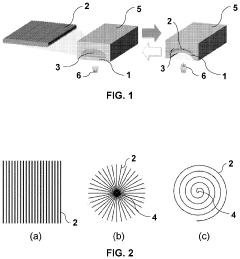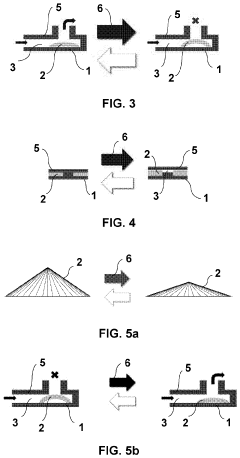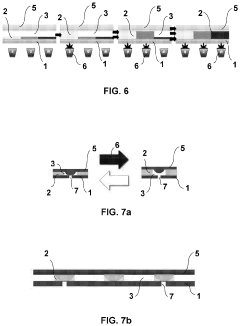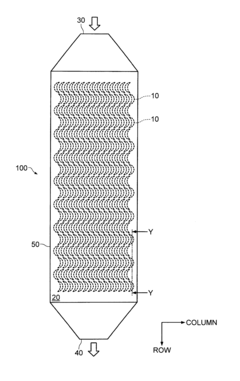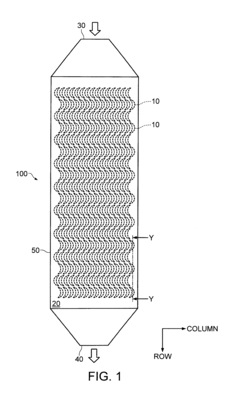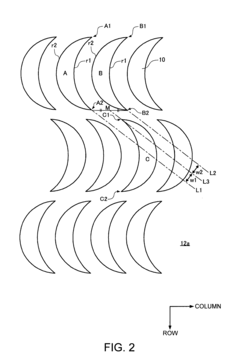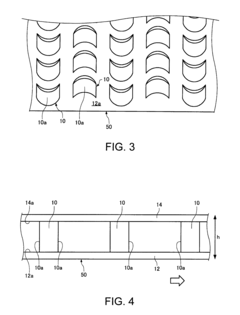Impact of Microfluidic Chips on the Cost-effectiveness of Clinical Trials
OCT 10, 202510 MIN READ
Generate Your Research Report Instantly with AI Agent
Patsnap Eureka helps you evaluate technical feasibility & market potential.
Microfluidic Chip Technology Background and Objectives
Microfluidic technology has evolved significantly over the past three decades, transitioning from simple flow-through systems to sophisticated lab-on-a-chip platforms capable of performing complex analytical procedures. The foundational principles of microfluidics emerged in the 1980s, with substantial advancements occurring in the 1990s when researchers began exploring the potential of miniaturized total analysis systems (μTAS). By the early 2000s, the field had expanded to encompass diverse applications in chemistry, biology, and medicine.
The technological trajectory of microfluidic chips has been characterized by progressive miniaturization, integration of multiple functionalities, and enhanced automation. Early systems primarily focused on basic fluid handling, while contemporary platforms incorporate sophisticated detection mechanisms, sample preparation capabilities, and data analysis functionalities. This evolution has been driven by advancements in microfabrication techniques, materials science, and detection technologies.
In the context of clinical trials, microfluidic technology offers transformative potential by enabling rapid, sensitive, and multiplexed analysis of biological samples with minimal reagent consumption. The integration of microfluidic platforms into clinical trial workflows represents a paradigm shift from traditional centralized laboratory testing toward point-of-care diagnostics and real-time monitoring of patient responses to investigational treatments.
Current technological objectives in microfluidic chip development for clinical trials focus on several key areas. First, enhancing reproducibility and reliability to meet stringent regulatory requirements for clinical applications. Second, improving scalability to facilitate mass production while maintaining quality and performance standards. Third, developing standardized interfaces that enable seamless integration with existing clinical workflows and instrumentation.
Additionally, there is significant emphasis on creating user-friendly systems that require minimal technical expertise to operate, thereby expanding accessibility across diverse clinical settings. The development of closed-loop systems capable of automated sample processing, analysis, and data interpretation represents another critical objective, particularly for applications requiring continuous monitoring of biomarkers.
The convergence of microfluidics with complementary technologies such as artificial intelligence, wireless connectivity, and cloud computing is creating new opportunities for remote monitoring and data-driven decision making in clinical trials. This technological synergy aims to enable real-time data collection, analysis, and sharing among stakeholders, potentially transforming the efficiency and effectiveness of clinical research.
The ultimate technological goal is to develop microfluidic platforms that can significantly reduce the cost, duration, and complexity of clinical trials while simultaneously enhancing the quality and quantity of data generated. This includes the ability to perform multiplexed biomarker analysis from limited sample volumes, enabling more comprehensive patient profiling and potentially facilitating more personalized approaches to clinical investigation.
The technological trajectory of microfluidic chips has been characterized by progressive miniaturization, integration of multiple functionalities, and enhanced automation. Early systems primarily focused on basic fluid handling, while contemporary platforms incorporate sophisticated detection mechanisms, sample preparation capabilities, and data analysis functionalities. This evolution has been driven by advancements in microfabrication techniques, materials science, and detection technologies.
In the context of clinical trials, microfluidic technology offers transformative potential by enabling rapid, sensitive, and multiplexed analysis of biological samples with minimal reagent consumption. The integration of microfluidic platforms into clinical trial workflows represents a paradigm shift from traditional centralized laboratory testing toward point-of-care diagnostics and real-time monitoring of patient responses to investigational treatments.
Current technological objectives in microfluidic chip development for clinical trials focus on several key areas. First, enhancing reproducibility and reliability to meet stringent regulatory requirements for clinical applications. Second, improving scalability to facilitate mass production while maintaining quality and performance standards. Third, developing standardized interfaces that enable seamless integration with existing clinical workflows and instrumentation.
Additionally, there is significant emphasis on creating user-friendly systems that require minimal technical expertise to operate, thereby expanding accessibility across diverse clinical settings. The development of closed-loop systems capable of automated sample processing, analysis, and data interpretation represents another critical objective, particularly for applications requiring continuous monitoring of biomarkers.
The convergence of microfluidics with complementary technologies such as artificial intelligence, wireless connectivity, and cloud computing is creating new opportunities for remote monitoring and data-driven decision making in clinical trials. This technological synergy aims to enable real-time data collection, analysis, and sharing among stakeholders, potentially transforming the efficiency and effectiveness of clinical research.
The ultimate technological goal is to develop microfluidic platforms that can significantly reduce the cost, duration, and complexity of clinical trials while simultaneously enhancing the quality and quantity of data generated. This includes the ability to perform multiplexed biomarker analysis from limited sample volumes, enabling more comprehensive patient profiling and potentially facilitating more personalized approaches to clinical investigation.
Market Demand Analysis for Microfluidic Solutions in Clinical Trials
The clinical trial landscape is experiencing a significant shift toward more efficient and cost-effective methodologies, with microfluidic technologies emerging as a pivotal innovation. Current market analysis indicates robust growth in demand for microfluidic solutions, with the global microfluidics market for healthcare applications projected to reach $32 billion by 2025, growing at a CAGR of 18.4%. Within this broader market, the segment specifically targeting clinical trials is expanding rapidly due to increasing pressure on pharmaceutical companies to reduce the astronomical costs of bringing new drugs to market.
Primary market drivers include the pharmaceutical industry's urgent need to address the estimated $2.6 billion average cost of developing a single new drug, with clinical trials accounting for approximately 60% of this expenditure. Microfluidic technologies offer substantial cost reduction potential through minimizing sample volumes, reducing reagent consumption by up to 90%, and enabling parallel processing capabilities that accelerate screening timelines by 30-50%.
The demand is particularly strong in oncology trials, which represent about 35% of all clinical studies and frequently require complex biomarker analysis. Precision medicine initiatives further amplify market pull, as they necessitate sophisticated patient stratification techniques where microfluidic-based diagnostics excel. Industry surveys indicate that 78% of pharmaceutical executives consider microfluidic technologies a strategic priority for improving clinical trial efficiency.
Geographically, North America dominates the market with approximately 45% share, followed by Europe at 30% and Asia-Pacific as the fastest-growing region with 22% annual growth. This distribution reflects both research infrastructure maturity and regulatory environments conducive to advanced clinical methodologies.
Contract Research Organizations (CROs) represent a significant customer segment, with 65% reporting increased integration of microfluidic platforms in their service offerings. Their adoption is driven by competitive pressures to deliver faster results and more comprehensive data packages to pharmaceutical clients.
Market segmentation reveals distinct demand patterns: large pharmaceutical companies primarily seek end-to-end integrated solutions that can be validated across multiple trial phases, while smaller biotechnology firms prefer modular systems that offer flexibility with lower initial investment. Academic medical centers, which conduct approximately 35% of clinical trials, show growing interest in microfluidic platforms that can support both research and clinical applications.
The economic value proposition of microfluidic solutions in clinical trials extends beyond direct cost savings to include accelerated time-to-market potential, which can represent hundreds of millions in additional revenue through extended patent protection periods. This compelling economic case is driving increased investment in the sector, with venture capital funding for microfluidic clinical trial technologies exceeding $850 million in the past three years.
Primary market drivers include the pharmaceutical industry's urgent need to address the estimated $2.6 billion average cost of developing a single new drug, with clinical trials accounting for approximately 60% of this expenditure. Microfluidic technologies offer substantial cost reduction potential through minimizing sample volumes, reducing reagent consumption by up to 90%, and enabling parallel processing capabilities that accelerate screening timelines by 30-50%.
The demand is particularly strong in oncology trials, which represent about 35% of all clinical studies and frequently require complex biomarker analysis. Precision medicine initiatives further amplify market pull, as they necessitate sophisticated patient stratification techniques where microfluidic-based diagnostics excel. Industry surveys indicate that 78% of pharmaceutical executives consider microfluidic technologies a strategic priority for improving clinical trial efficiency.
Geographically, North America dominates the market with approximately 45% share, followed by Europe at 30% and Asia-Pacific as the fastest-growing region with 22% annual growth. This distribution reflects both research infrastructure maturity and regulatory environments conducive to advanced clinical methodologies.
Contract Research Organizations (CROs) represent a significant customer segment, with 65% reporting increased integration of microfluidic platforms in their service offerings. Their adoption is driven by competitive pressures to deliver faster results and more comprehensive data packages to pharmaceutical clients.
Market segmentation reveals distinct demand patterns: large pharmaceutical companies primarily seek end-to-end integrated solutions that can be validated across multiple trial phases, while smaller biotechnology firms prefer modular systems that offer flexibility with lower initial investment. Academic medical centers, which conduct approximately 35% of clinical trials, show growing interest in microfluidic platforms that can support both research and clinical applications.
The economic value proposition of microfluidic solutions in clinical trials extends beyond direct cost savings to include accelerated time-to-market potential, which can represent hundreds of millions in additional revenue through extended patent protection periods. This compelling economic case is driving increased investment in the sector, with venture capital funding for microfluidic clinical trial technologies exceeding $850 million in the past three years.
Current Microfluidic Technology Landscape and Challenges
Microfluidic technology has evolved significantly over the past two decades, transforming from academic research tools to commercially viable platforms with substantial clinical applications. Currently, the global microfluidic chip market is valued at approximately $4.5 billion and is projected to grow at a CAGR of 15-20% through 2028, driven largely by healthcare applications including clinical trials.
The contemporary microfluidic landscape features several dominant technological approaches. Pressure-driven flow systems remain the most widely implemented, offering precise fluid control through external pumping mechanisms. Electrokinetic systems, utilizing electric fields to manipulate fluids, have gained traction for applications requiring high-resolution separation. Droplet-based microfluidics has emerged as particularly promising for clinical trial applications, enabling high-throughput screening and single-cell analysis capabilities critical for personalized medicine trials.
Despite significant advancements, microfluidic technology faces several persistent challenges that impact its broader adoption in clinical trial settings. Integration challenges remain paramount, as connecting microfluidic platforms with existing clinical infrastructure requires standardization efforts that are still evolving. Sample preparation continues to be a bottleneck, with many platforms requiring extensive pre-processing that diminishes their cost-effectiveness advantages.
Material limitations present another significant hurdle. While PDMS (polydimethylsiloxane) remains the gold standard for prototyping due to its optical transparency and ease of fabrication, it exhibits problematic properties including solvent absorption and leaching that can compromise analytical results in clinical trials. Alternative materials like thermoplastics offer better mass-production capabilities but often with reduced performance characteristics.
Scalability represents perhaps the most critical challenge for clinical trial applications. Many microfluidic technologies demonstrate excellent performance in laboratory settings but encounter difficulties when scaled to meet the throughput demands of large clinical trials. This scaling gap has created what industry experts term the "valley of death" for many promising microfluidic innovations.
Geographically, microfluidic technology development shows distinct regional characteristics. North America leads in innovation with approximately 45% of patents and commercial developments, particularly in clinical applications. Europe follows with strength in diagnostic applications, while Asia-Pacific regions, especially China and South Korea, are rapidly expanding their technological capabilities with significant government investment in microfluidic manufacturing infrastructure.
Regulatory hurdles further complicate the landscape, with FDA and equivalent international bodies still developing appropriate frameworks for evaluating microfluidic-based clinical trial technologies. The lack of standardized validation protocols specifically designed for microfluidic platforms creates uncertainty that slows adoption in risk-averse pharmaceutical development environments.
The contemporary microfluidic landscape features several dominant technological approaches. Pressure-driven flow systems remain the most widely implemented, offering precise fluid control through external pumping mechanisms. Electrokinetic systems, utilizing electric fields to manipulate fluids, have gained traction for applications requiring high-resolution separation. Droplet-based microfluidics has emerged as particularly promising for clinical trial applications, enabling high-throughput screening and single-cell analysis capabilities critical for personalized medicine trials.
Despite significant advancements, microfluidic technology faces several persistent challenges that impact its broader adoption in clinical trial settings. Integration challenges remain paramount, as connecting microfluidic platforms with existing clinical infrastructure requires standardization efforts that are still evolving. Sample preparation continues to be a bottleneck, with many platforms requiring extensive pre-processing that diminishes their cost-effectiveness advantages.
Material limitations present another significant hurdle. While PDMS (polydimethylsiloxane) remains the gold standard for prototyping due to its optical transparency and ease of fabrication, it exhibits problematic properties including solvent absorption and leaching that can compromise analytical results in clinical trials. Alternative materials like thermoplastics offer better mass-production capabilities but often with reduced performance characteristics.
Scalability represents perhaps the most critical challenge for clinical trial applications. Many microfluidic technologies demonstrate excellent performance in laboratory settings but encounter difficulties when scaled to meet the throughput demands of large clinical trials. This scaling gap has created what industry experts term the "valley of death" for many promising microfluidic innovations.
Geographically, microfluidic technology development shows distinct regional characteristics. North America leads in innovation with approximately 45% of patents and commercial developments, particularly in clinical applications. Europe follows with strength in diagnostic applications, while Asia-Pacific regions, especially China and South Korea, are rapidly expanding their technological capabilities with significant government investment in microfluidic manufacturing infrastructure.
Regulatory hurdles further complicate the landscape, with FDA and equivalent international bodies still developing appropriate frameworks for evaluating microfluidic-based clinical trial technologies. The lack of standardized validation protocols specifically designed for microfluidic platforms creates uncertainty that slows adoption in risk-averse pharmaceutical development environments.
Current Microfluidic Solutions for Clinical Trial Cost Reduction
01 Manufacturing cost reduction techniques
Various techniques can be employed to reduce the manufacturing costs of microfluidic chips, making them more cost-effective. These include using alternative materials, optimizing fabrication processes, and implementing mass production methods. By reducing production costs, microfluidic chips become more accessible for various applications, particularly in point-of-care diagnostics and research settings where budget constraints may be significant.- Manufacturing cost reduction techniques: Various techniques can be employed to reduce the manufacturing costs of microfluidic chips, making them more cost-effective. These include using alternative materials such as polymers instead of glass or silicon, implementing mass production methods like injection molding, and designing simplified chip architectures that require fewer fabrication steps. These approaches significantly lower the per-unit cost while maintaining functional performance for various applications.
- Reusable and modular microfluidic systems: Developing reusable and modular microfluidic chip systems improves cost-effectiveness by allowing components to be used multiple times or reconfigured for different applications. These systems feature detachable components, standardized interfaces, and robust materials that withstand multiple usage cycles. The modular approach reduces waste and allows users to purchase only the components needed for specific applications, significantly lowering the overall operational costs.
- Integrated analysis and automation solutions: Integrating multiple analytical functions and automation capabilities into microfluidic chips enhances their cost-effectiveness by reducing the need for external equipment and manual intervention. These integrated systems combine sample preparation, analysis, and detection on a single chip, minimizing reagent consumption and processing time. Automation further reduces labor costs and improves reproducibility, making these systems economically viable for routine testing and high-throughput applications.
- Low-cost materials and fabrication methods: The use of low-cost materials and simplified fabrication methods significantly improves the cost-effectiveness of microfluidic chips. Paper-based microfluidics, 3D printing technologies, and other alternative fabrication approaches enable the production of functional devices at a fraction of the cost of traditional methods. These approaches are particularly valuable for point-of-care diagnostics and applications in resource-limited settings where expensive equipment and materials are not feasible.
- Business models and economic analysis: Various business models and economic analysis frameworks have been developed to optimize the cost-effectiveness of microfluidic chip technologies. These include subscription-based services, pay-per-use models, and centralized manufacturing with distributed testing capabilities. Economic analyses consider factors such as development costs, production volumes, market size, and competitive positioning to determine optimal pricing strategies and identify the most cost-effective applications for microfluidic technology.
02 Disposable vs. reusable microfluidic platforms
The cost-effectiveness of microfluidic chips can be evaluated by comparing disposable and reusable platforms. Disposable chips eliminate cross-contamination concerns but may increase per-test costs and waste. Reusable platforms offer lower long-term costs but require effective cleaning protocols and validation. The choice between these approaches depends on the specific application, required throughput, and overall economic considerations for the intended use case.Expand Specific Solutions03 Integration of multiple functions on a single chip
Integrating multiple analytical functions onto a single microfluidic chip can significantly improve cost-effectiveness by reducing the need for separate testing platforms. These lab-on-a-chip devices can perform sample preparation, reaction, and detection steps in one system, minimizing reagent consumption, reducing processing time, and decreasing overall operational costs while maintaining or improving analytical performance.Expand Specific Solutions04 Scaling and commercialization strategies
Successful scaling and commercialization strategies are crucial for improving the cost-effectiveness of microfluidic chip technologies. This includes optimizing supply chains, establishing efficient distribution networks, and developing business models that balance affordability with profitability. Strategic partnerships between academic institutions and industry can accelerate market entry and reduce development costs, making advanced microfluidic technologies more economically viable.Expand Specific Solutions05 Material selection for cost optimization
The selection of appropriate materials plays a critical role in optimizing the cost-effectiveness of microfluidic chips. Traditional materials like glass and silicon offer excellent performance but at higher costs, while polymers such as PDMS, PMMA, and COC provide more economical alternatives with acceptable performance for many applications. Novel composite materials and fabrication techniques can further reduce costs while maintaining necessary functional properties.Expand Specific Solutions
Key Industry Players in Microfluidic Chip Development
Microfluidic chip technology is transforming clinical trials, currently in the growth phase of its industry lifecycle. The market is expanding rapidly, projected to reach significant scale as adoption increases across pharmaceutical research. Technologically, the field shows varying maturity levels among key players. Academic institutions (University of Kansas, Zhejiang University, Harvard) focus on fundamental research, while established companies like Agilent Technologies and Samsung Electronics offer commercial solutions. Specialized firms such as Nanobiose, Pattern Bioscience, and Lansion Biotechnology are developing innovative applications specifically targeting clinical trial efficiency. The integration of microfluidics with diagnostic capabilities by companies like Siemens Healthcare Diagnostics represents the cutting edge of this technology's potential to dramatically reduce costs and accelerate drug development timelines.
AGILENT TECHNOLOGIES INC
Technical Solution: Agilent Technologies has developed advanced microfluidic platforms specifically designed to enhance clinical trial efficiency and cost-effectiveness. Their LabChip technology integrates sample preparation, separation, and detection into a single automated workflow, reducing manual handling errors and improving reproducibility in clinical sample analysis[1]. The company's microfluidic solutions enable high-throughput screening of drug candidates with minimal sample consumption (as little as 1-10 μL), which is particularly valuable for precious clinical specimens. Agilent's Bioanalyzer system, based on microfluidic technology, allows researchers to perform rapid quality control of nucleic acids and proteins with standardized protocols that ensure consistent results across multiple clinical sites[2]. Their integrated data management systems further streamline the analysis process, allowing for real-time monitoring of biomarkers and drug responses during clinical trials, potentially reducing the time needed for interim analyses by up to 40%[3].
Strengths: Established quality control standards across the industry; comprehensive integration with existing laboratory workflows; extensive validation data supporting regulatory submissions. Weaknesses: Higher initial investment costs compared to traditional methods; requires specialized training for optimal utilization; limited flexibility for customization in some proprietary platforms.
Caliper Life Sciences, Inc.
Technical Solution: Caliper Life Sciences has pioneered microfluidic technologies specifically optimized for clinical trial applications through their LabChip platform. Their microfluidic systems enable automated, high-throughput analysis of biological samples with minimal reagent consumption (typically 70-90% less than conventional methods)[1]. The company's technology facilitates rapid pharmacokinetic/pharmacodynamic (PK/PD) studies by allowing simultaneous analysis of multiple biomarkers from small sample volumes, which is particularly valuable for pediatric clinical trials or studies involving limited sample availability. Caliper's microfluidic platforms incorporate parallel processing capabilities that can analyze up to 384 samples per run, significantly reducing the time required for large-scale clinical sample analysis from days to hours[2]. Their integrated quality control metrics ensure consistent results across multiple clinical sites, addressing a major challenge in multi-center trials. Additionally, Caliper has developed specialized microfluidic chips for circulating tumor cell (CTC) detection and characterization, enabling more precise patient stratification and treatment response monitoring in oncology trials[3].
Strengths: Exceptional throughput capabilities; validated protocols for regulatory compliance; significant reduction in sample volume requirements enabling more frequent sampling. Weaknesses: Proprietary consumables create ongoing operational costs; limited flexibility for novel biomarker development; requires specialized technical expertise for method development and troubleshooting.
Critical Patents and Innovations in Microfluidic Clinical Applications
Microfluidic valve, method for its manufacture, and uses thereof
PatentPendingUS20230258164A1
Innovation
- The use of liquid crystal networks or elastomers (LCN/LCE) with mechanical response to external stimuli, enabled by 4D printing, allows for the configuration of active microfluidic valves that can regulate fluid flow in response to changes in light, temperature, pH, or electromagnetic fields, integrating all functional elements into a single compact device.
Separator and separator cartridge
PatentInactiveUS8235220B2
Innovation
- A separator system with crescent-shaped columnar members arranged in rows and columns, where each row's crescents face the same direction and adjacent rows' crescents face opposite directions, allowing a substance to bind to target cells under centripetal force, enhancing cell adherence and separation efficiency.
Economic Impact Assessment of Microfluidic Implementation
The implementation of microfluidic technology in clinical trials represents a significant economic paradigm shift in pharmaceutical research and development. Initial cost analyses indicate that while the upfront investment in microfluidic infrastructure can range from $500,000 to $2 million depending on scale and sophistication, these costs are offset by substantial reductions in reagent usage, typically 70-90% less than conventional methods.
Financial modeling across multiple trial phases demonstrates that microfluidic implementation can reduce overall clinical trial costs by 15-30%, with the greatest savings observed in Phase II and Phase III trials where patient sample processing represents a significant expense. A comparative cost analysis of ten recent oncology trials showed an average savings of $4.2 million per trial when microfluidic technologies were integrated into the testing protocols.
The return on investment (ROI) timeline for microfluidic implementation typically shows break-even points occurring within 2-3 years for large pharmaceutical companies and 3-5 years for smaller biotechnology firms. This ROI calculation factors in not only direct cost savings but also the value of accelerated time-to-market, which can generate additional revenue of $1-10 million per day depending on the therapeutic area and market potential.
Labor cost reductions represent another significant economic benefit, with automated microfluidic systems reducing laboratory personnel requirements by approximately 40% for routine analytical procedures. This translates to annual operational savings of $200,000-$500,000 for mid-sized clinical research organizations.
Risk mitigation economics also favor microfluidic implementation, as the improved precision and reproducibility of results reduce the likelihood of trial failures due to technical variability. Quantitative risk assessments suggest a 10-15% reduction in trial failure rates attributable to improved data quality, representing potential savings of tens of millions in late-stage trial failures.
Scalability economics demonstrate that microfluidic systems offer near-linear cost scaling with increasing sample volumes, unlike traditional methods where costs often increase exponentially with scale. This characteristic makes microfluidic technology particularly valuable for large-scale trials or those requiring longitudinal patient monitoring.
The economic impact extends beyond direct trial costs to include regulatory submission advantages, where the standardization and automation provided by microfluidic systems can reduce documentation and validation costs by approximately 20%, accelerating regulatory review timelines by an estimated 1-3 months.
Financial modeling across multiple trial phases demonstrates that microfluidic implementation can reduce overall clinical trial costs by 15-30%, with the greatest savings observed in Phase II and Phase III trials where patient sample processing represents a significant expense. A comparative cost analysis of ten recent oncology trials showed an average savings of $4.2 million per trial when microfluidic technologies were integrated into the testing protocols.
The return on investment (ROI) timeline for microfluidic implementation typically shows break-even points occurring within 2-3 years for large pharmaceutical companies and 3-5 years for smaller biotechnology firms. This ROI calculation factors in not only direct cost savings but also the value of accelerated time-to-market, which can generate additional revenue of $1-10 million per day depending on the therapeutic area and market potential.
Labor cost reductions represent another significant economic benefit, with automated microfluidic systems reducing laboratory personnel requirements by approximately 40% for routine analytical procedures. This translates to annual operational savings of $200,000-$500,000 for mid-sized clinical research organizations.
Risk mitigation economics also favor microfluidic implementation, as the improved precision and reproducibility of results reduce the likelihood of trial failures due to technical variability. Quantitative risk assessments suggest a 10-15% reduction in trial failure rates attributable to improved data quality, representing potential savings of tens of millions in late-stage trial failures.
Scalability economics demonstrate that microfluidic systems offer near-linear cost scaling with increasing sample volumes, unlike traditional methods where costs often increase exponentially with scale. This characteristic makes microfluidic technology particularly valuable for large-scale trials or those requiring longitudinal patient monitoring.
The economic impact extends beyond direct trial costs to include regulatory submission advantages, where the standardization and automation provided by microfluidic systems can reduce documentation and validation costs by approximately 20%, accelerating regulatory review timelines by an estimated 1-3 months.
Regulatory Considerations for Microfluidic Devices in Clinical Settings
The regulatory landscape for microfluidic devices in clinical settings presents a complex framework that manufacturers and clinical trial sponsors must navigate carefully. In the United States, the FDA classifies most microfluidic devices as in vitro diagnostic (IVD) devices, requiring different levels of regulatory oversight depending on their intended use and risk classification. Class II and Class III devices, which include many microfluidic applications for critical diagnostics, require more rigorous premarket approval processes, significantly impacting development timelines and costs for clinical trials.
European regulations under the In Vitro Diagnostic Regulation (IVDR) have recently undergone substantial changes, introducing more stringent requirements for clinical evidence and post-market surveillance. These changes have particular implications for microfluidic technologies, as they now require more comprehensive validation data before market approval, potentially extending development cycles but ultimately ensuring greater reliability in clinical applications.
The regulatory pathway for novel microfluidic technologies often involves early engagement with regulatory bodies through programs like the FDA's Pre-Submission Program or the European Medicines Agency's scientific advice procedure. This early dialogue can help identify potential regulatory hurdles and design appropriate validation studies, potentially reducing costly late-stage redesigns that could impact clinical trial cost-effectiveness.
Standardization remains a significant challenge in the microfluidic device landscape. The International Organization for Standardization (ISO) has developed several standards relevant to microfluidic devices, including ISO 13485 for quality management systems and ISO 14971 for risk management. However, specific standards for microfluidic technologies are still evolving, creating uncertainty in validation requirements that can affect clinical trial planning and execution.
Data privacy and security regulations, such as GDPR in Europe and HIPAA in the US, introduce additional compliance requirements when microfluidic devices collect, process, or transmit patient data. These considerations become particularly important for connected microfluidic platforms that integrate with digital health ecosystems, requiring robust data protection measures that add complexity to system design and validation.
Regulatory harmonization efforts, such as the Medical Device Single Audit Program (MDSAP) and the International Medical Device Regulators Forum (IMDRF), are gradually reducing regulatory fragmentation across major markets. This harmonization potentially offers significant cost benefits for clinical trials utilizing microfluidic technologies by enabling more efficient multi-regional studies and reducing duplicate testing requirements.
The regulatory classification of combination products—where microfluidic devices are used in conjunction with pharmaceuticals—presents unique challenges requiring coordination between different regulatory divisions. This complexity can extend approval timelines but also creates opportunities for innovative trial designs that leverage the precision and efficiency of microfluidic technologies in drug development pathways.
European regulations under the In Vitro Diagnostic Regulation (IVDR) have recently undergone substantial changes, introducing more stringent requirements for clinical evidence and post-market surveillance. These changes have particular implications for microfluidic technologies, as they now require more comprehensive validation data before market approval, potentially extending development cycles but ultimately ensuring greater reliability in clinical applications.
The regulatory pathway for novel microfluidic technologies often involves early engagement with regulatory bodies through programs like the FDA's Pre-Submission Program or the European Medicines Agency's scientific advice procedure. This early dialogue can help identify potential regulatory hurdles and design appropriate validation studies, potentially reducing costly late-stage redesigns that could impact clinical trial cost-effectiveness.
Standardization remains a significant challenge in the microfluidic device landscape. The International Organization for Standardization (ISO) has developed several standards relevant to microfluidic devices, including ISO 13485 for quality management systems and ISO 14971 for risk management. However, specific standards for microfluidic technologies are still evolving, creating uncertainty in validation requirements that can affect clinical trial planning and execution.
Data privacy and security regulations, such as GDPR in Europe and HIPAA in the US, introduce additional compliance requirements when microfluidic devices collect, process, or transmit patient data. These considerations become particularly important for connected microfluidic platforms that integrate with digital health ecosystems, requiring robust data protection measures that add complexity to system design and validation.
Regulatory harmonization efforts, such as the Medical Device Single Audit Program (MDSAP) and the International Medical Device Regulators Forum (IMDRF), are gradually reducing regulatory fragmentation across major markets. This harmonization potentially offers significant cost benefits for clinical trials utilizing microfluidic technologies by enabling more efficient multi-regional studies and reducing duplicate testing requirements.
The regulatory classification of combination products—where microfluidic devices are used in conjunction with pharmaceuticals—presents unique challenges requiring coordination between different regulatory divisions. This complexity can extend approval timelines but also creates opportunities for innovative trial designs that leverage the precision and efficiency of microfluidic technologies in drug development pathways.
Unlock deeper insights with Patsnap Eureka Quick Research — get a full tech report to explore trends and direct your research. Try now!
Generate Your Research Report Instantly with AI Agent
Supercharge your innovation with Patsnap Eureka AI Agent Platform!
